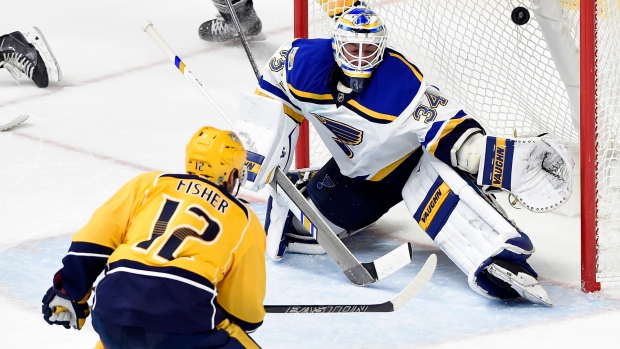Feb 2, 2017
Hitchcock firing a reminder you can’t win without goaltending
St. Louis Blues fans know full well how the netminding has abandoned their team this season, Travis Yost writes.
By Travis Yost

Let’s make something perfectly clear: There are two reasons Ken Hitchcock is no longer head coach of the St. Louis Blues.
Reason one is that the team mostly floundered in the playoffs under Hitchcock. Outside of last year’s run to the Western Conference finals, the Blues were hit with too many early postseason exits during his reign that no doubt left a sour taste in the mouths of senior management.
Reason two is that the goaltending in St. Louis has been a nightmare. And at least in the immediate sense, it’s the biggest driver for the change in bench bosses.
Hitchcock isn’t the first coach to be turfed predominantly because of the play of his goaltenders, nor will he be the last. Blues fans know full well how the netminding has abandoned their team in a year when they really need it, but on a national level, I suspect some don’t fully grasp the magnitude of the drop-off this season.
The Blues in the Hitchcock era were a tightly structured, hard-to-score-against team that in many ways mimicked the strategies of Darryl Sutter’s teams in Los Angeles. One interesting note about the Blues – predating this season, anyway – is that the team has historically had pretty strong goaltending without significant financial investment.
There’s probably something to be said about how Hitchcock’s defensive systems have unburdened the difficulty and workload incurred by Blues goaltenders. But at the end of the day, his goalies in St. Louis have stopped shots. In fact, from 2011-16, the Blues were actually the league’s third-best team at stopping shots – trailing only Henrik Lundqvist’s New York Rangers and Tuukka Rask’s Boston Bruins.

You’ll notice that almost every one of these teams has ranged from strong to elite over that five-year window. That’s not a fluke. So much of hockey today is about, at least foundationally, having sustainable and competent goaltending from October through April (and beyond). Once your goaltending is figured out it’s about winning at the margins – putting systems in place to maximize talent efficiency, identifying areas of opportunity for player development and acquisition, et al.
But you simply cannot win without goaltending. Not in a league where scoring is really at record lows and every incremental goal given up means increasing likelihood of failure. It takes Herculean efforts – think of the Dallas Stars last season as one example – in other areas of the game to try and overcome porous goaltending.
This year, something broke in St. Louis. Maybe, structurally, the team isn’t what it used to be. Maybe the skating talent isn’t there. Maybe the front office underestimated the loss of Brian Elliott, or overstated the value a tandem of Jake Allen and Carter Hutton could provide. But at the end of the day, the Blues simply cannot stop a shot. That’s why the Blues are 16 goals in the red and 21st overall in goal differential.
Something to keep in mind before you look at this year’s data table is that hidden in the five-year save percentages noted above is the fact that St. Louis was the best team in the league at stopping shots last season (92.0 per cent in all situations). This year? Well, it’s certainly different!

The Blues have gone from the league’s most effective shot-stopping team to the league’s least effective. What’s interesting is that it’s not as if their goaltenders are facing a newly challenging workload here. The Blues are giving up a very low volume of shots – fifth-lowest in the league. Allen and Hutton, the two goalies Blues management bet on to replace the vacancy left by Elliott, have turned in comparably nightmarish performances.
So, why can one confidently argue that this is another goaltenders-fired-the-coach scenario? Well, consider where the Blues would be if they had received the goaltending they had grown accustomed to in the Hitchcock era. At a 91.7 per cent save percentage, the Blues would have scored 141 goals and conceded 115 goals. That’s a 42-goal swing! And that +26 goal differential would put them significantly higher in the standings – it would be the second-best differential in the Western Conference and most directly comparable to the Montreal Canadiens, a team that currently sits first in the Atlantic Division.
Even if you wanted to take a conservative approach and assumed league average stop rates for this year instead of the ghastly 88.7 per cent, the Blues would be at about 122 goals against – still +19 in goals and almost certainly in the playoff race.
It’s hard to overemphasize just how pitiful the goaltending has been in St. Louis this season. Maybe we shouldn’t be surprised at how the lack of investment at the position finally came back to bite the franchise. At the end of the day, this roster had legitimate playoff expectations and is failing to live up to them.
Mike Yeo will need to turn it around – and in a hurry – if St. Louis wants a shot at getting back into this playoff race.


